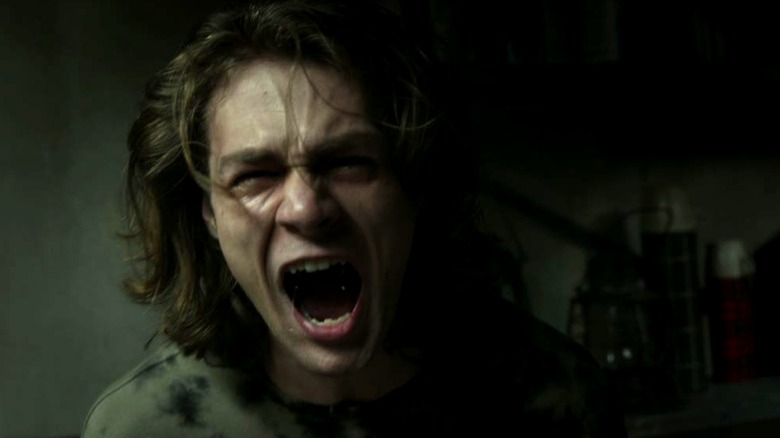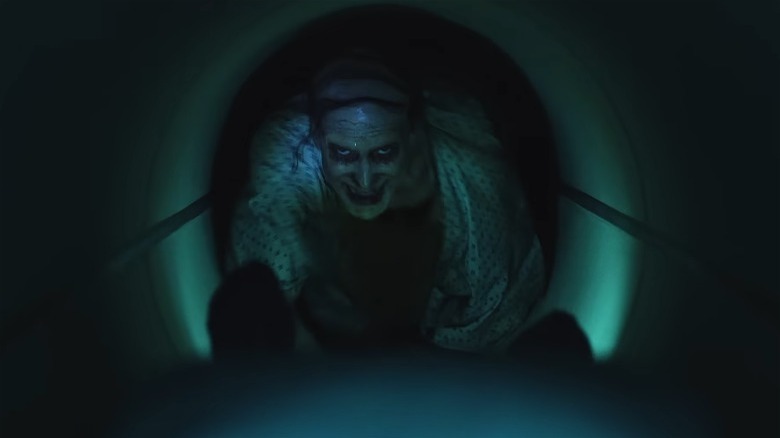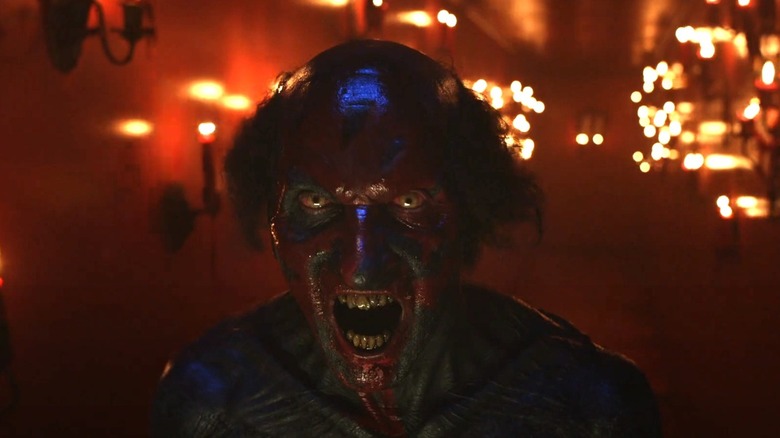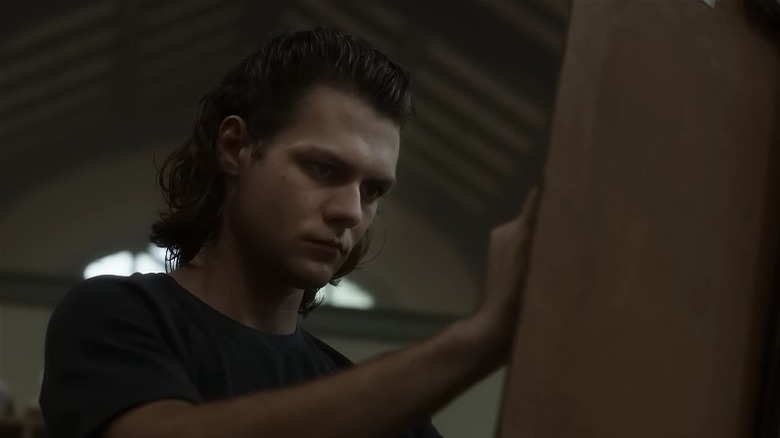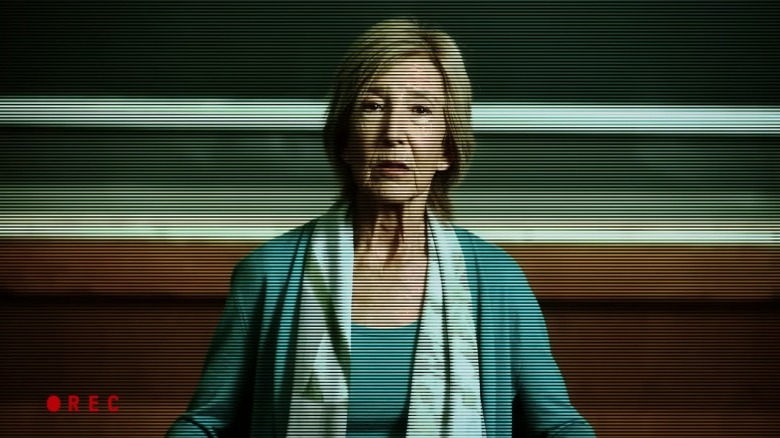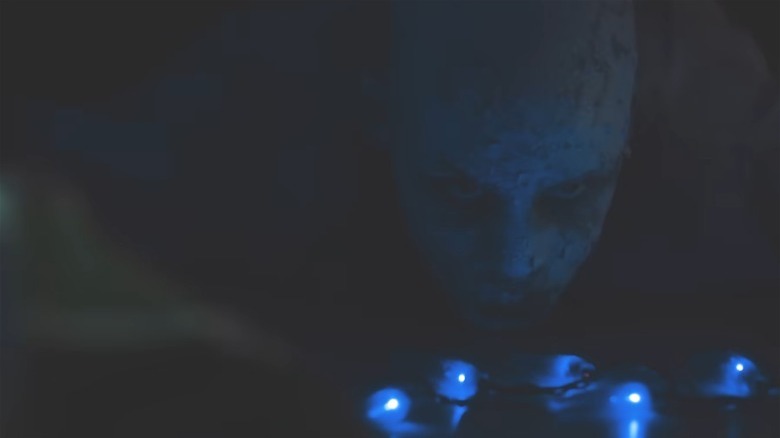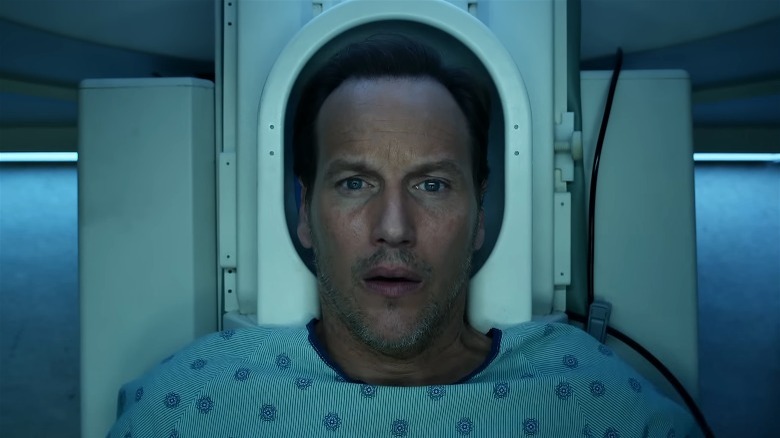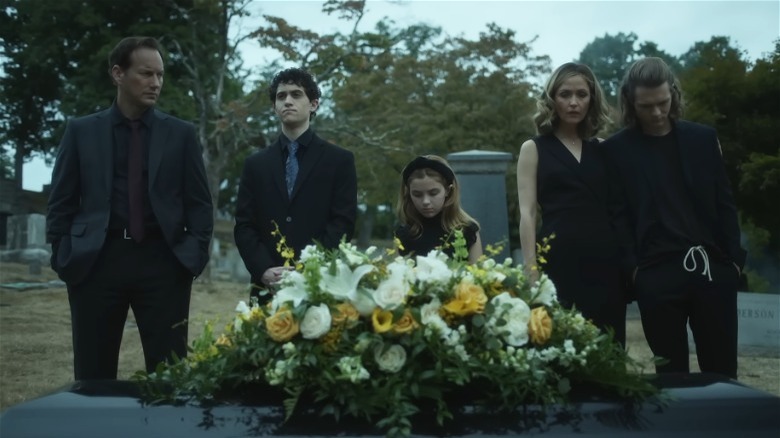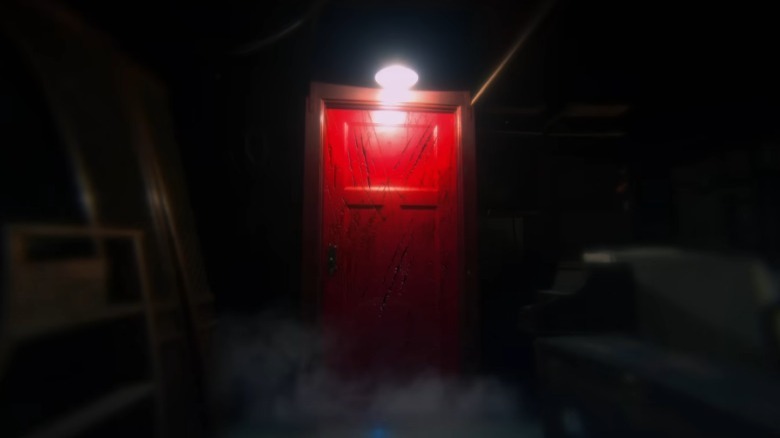Insidious: The Red Door Ending Explained
Director James Wan's Patrick Wilson-starring horror franchise "The Conjuring" came to dominate horror in the 2010s, releasing three movies in the main series and a whole host of spin-offs. Two years before "The Conjuring," however, there was "Insidious," another Wilson-led Wan project. The first two installments in the series centered around the haunting of the Lambert family, which in addition to Wilson's Josh included his wife Renai (Rose Byrne), their son Dalton (Ty Simpkins), and two other kids. Josh and Dalton both have the ability to astral-project, sending their consciousness into a realm called The Further, but doing so leaves their bodies open for other entities to enter the realm of the living.
The third and fourth films were prequels focused on Lin Shaye's psychic character Elise, but "Insidious: The Red Door" picks up the Lamberts' story nearly a decade after "Insidious: Chapter 2," with Wilson not only reprising the lead role but making his directorial debut. Father and son had their memories wiped at the end of the second movie, but in the fifth installment they return to The Further one last time. As with most "Insidious" movies, this involves some creepy ghosts, some twisted timelines, and a certain demon with a red face and a penchant for playing old-timey records.
"Insidious: The Red Door" concludes the Lambert family's journey into the spirit realm, but the way it's executed leaves some lingering questions for fans, especially those who may not remember the rest of the series. Let's take a look at the end of "The Red Door" and what it all means.
What you need to remember about the plot of Insidious: The Red Door
"Insidious: The Red Door" picks up nine years after Josh and Dalton Lambert had their memories of The Further suppressed. Josh and Renai have divorced, Josh's mother has died, and Dalton is headed to college. Josh is reeling, re-examining his relationships with his loved ones. He drives a moody Dalton to school, but they argue when they reach the dorm; while Josh confesses that he's felt brain fog for awhile, Dalton isn't interested in excuses.
Back home, Josh attempts to figure out what's wrong. He goes in for an MRI and has a vision of the lights going out. A ghost in a hospital gown attacks him in the MRI machine, but the doctor says he's merely been asleep. The results come back clean, and the doctor suggests playing a memory game to help strengthen his mind. While he does so, a different ghost bursts through the window and attacks him, sending him on a journey to learn about his own father.
At college, Dalton — an art student — draws a mysterious red door that he feels is connected to his childhood. At a frat party with his new friend Chris (Sinclair Daniel), Dalton encounters a vomiting ghost who warns him, "Close the door!" Dalton begins to experiment with astral projection as he uncovers memories of just what happened to him when he was younger, and a familiar demon with a red face takes notice.
What happened at the end of Insidious: The Red Door?
Dalton completes his painting and realizes it's his father who once attacked the family with a hammer. Traveling into The Further, he witnesses the events of the second movie's climax — Josh, possessed by The Bride in Black, threatening the family in the basement. In the present, the Lipstick-Faced Demon grabs Dalton and chains him up in his lair, possessing his body in the real world and attacking Chris.
At the same time, Josh talks with Renai, who finally tells him what happened all those years ago. They realize Dalton is in danger, and Josh travels into The Further to rescue him. The demon notices what's happening and leaves Dalton's body to chase father and son through The Further. They escape through the red door, but the demon begins breaking it down. Josh tells Dalton to go, echoing his own father's suicide note: "This ends with me." Back in the real world, Dalton blots out his painting of the red door, causing the real one in The Further to turn black and trap the demon. Wandering the void, Josh comes across the ghost of his father, who sets down a lantern before disappearing in a flash of white light.
Josh returns to his body. Outside, he receives a visit from Elise, not realizing at first that she's a ghost. Finally, he surprises his son at school, where Dalton has painted Josh rescuing him from The Further over the image of the blacked-out door.
If you or someone you know needs support now, call or text 988 or chat 988lifeline.org.
Why does Dalton's painting control the red door?
In the first "Insidious," a young Dalton draws a red door with crayons, then we see the actual thing when Josh enters The Further. "The red door" looks different in "Insidious: Chapter 3," as Elise enters The Further through red elevator-like doors. "Insidious: The Last Key" — a prequel — expands the symbolism even more, imagining a Further hallway full of red doors, each giving a window into the real world. These red doors, we learn, are controlled by the Keyface Demon. Elise inadvertently leaves the red door to the Lamberts' attic open, suggesting that she's accidentally responsible for kicking off the events of the first film.
The red door in "Insidious: The Red Door" seems to function differently than in the others. This time, Dalton doesn't have to literally open a door to let something through; simply by accessing the suppressed memory — by drawing it — he activates it. This is clear because the bathroom ghost orders him to close the door before we've actually seen a physical door being opened, suggesting that Dalton's art is itself the portal to The Further.
As a result, Dalton painting over the artwork in the film's climax has the effect of damaging the door in The Further. However, Dalton tells Chris that he doesn't want to destroy the memory. Instead, the blacked-out door becomes the background for a new painting, one memorializing his father's bravery. The "door" is still there, but this happy memory prevents it from being opened.
What does Elise's message mean?
After rescuing Dalton from The Further — and finding himself on the receiving end of a dinner invite from his ex-wife — Josh is feeling high on life as he heads out to his car. A familiar voice greets him and asks if he lives in this house, and he replies, "I hope so." After apologizing that he feels lost in memory, Josh realizes that the woman looks familiar.
It's Elise, the psychic who died in the first film and has appeared in all of the sequels. This time, Elise has a message for Josh. Looking beatific, she tells him that someday he will be able to speak to his mother again, but not for a long time. "Keep a steady stride, Josh," she says by way of parting. But what does that mean?
The phrase is a callback to Elise's earlier appearance in the movie, in a YouTube video that Dalton and Chris watch. In the video, Elise gives a lecture about astral projection. After discussing the dangers inherent in traveling to The Further, Elise offers the same advice. "Keep a steady stride" is a warning, a way to ensure you are moving purposely through The Further so you can limit your time away from your body. At the end of "Insidious: The Red Door," though, it's a message of hope, an affirmation that he'll be okay as long as he just keeps going. It's an especially resonant idea, considering Josh's father died by suicide.
Who were the ghosts in the dorm?
"Insidious: The Red Door" gives most of its ghosts backstories. The bathroom ghost who vomits on Dalton died at the frat house, presumably in what frat boy Nick the D*** calls "The Incident." Also, the ghost who attacks Josh while he's playing his memory game turns out to be Josh's father, who took his own life in 1978. At the end, however, there are suddenly a number of new ghosts we've never seen before. They attack Chris while she's guarding Dalton's body, crawling all over the dorm room, emerging from under the bed and inside the wardrobe. Who are they?
We need to revisit the way the first "Insidious" film explains astral projection. Elise tells the Lambert family, "With [Dalton's] astral body gone, he's just left us with a physical body. An empty vessel. There are entities that know this, because they can smell it. That's why they're gathered around him. They're all trying to get inside of his physical body simply because they crave life. A chance to live again." These are separate beings from those like the Lipstick-Faced Demon, who Elise says "has a more insidious [!] agenda."
We can assume the dorm ghosts in "Insidious: The Red Door" are the same. They are spirits who can smell the fact that Dalton's body is empty, and they want to possess it so that they can live once more. That's why, when he wakes up, they vanish.
What has the director of Insidious: The Red Door said about the ending?
Don't expect "Insidious: The Red Door" director and star Patrick Wilson to agree to another sequel any time soon. Wilson spoke about the end of the film with Bloody Disgusting, and he revealed that, as far as he's concerned, the end of the movie signals the end of the Lambert family's story. "It feels pretty final for the Lamberts as a family unit," he said. However, Wilson is open to being wrong ... as long as he gets a bit of a break. "Now that being said, come back in ten years, it'd be cool to do kinda like the 'Boyhood' thing before, but for now, we've definitely closed the door — in more ways than one."
Lin Shaye agrees that the end of "Insidious: The Red Door" provides a good sense of closure. "I think it's very savvy to be a creator and know when it's good to have an ending, and I think this was a really wonderful [end]," she told Screen Rant. Shaye further clarified, "It doesn't mean the world of 'Insidious' is necessarily over, but it does mean that particular story has a beginning, middle and end now, and I applaud it."
What the end of Insidious: The Red Door could mean for the franchise
In short, the ending of "Insidious: The Red Door" likely means that we won't see the Lambert family again ... at least, not for a while. By the end of the film, the relationship between father and son has been resolved, and we're even given a glimmer of hope that Josh may be able to reconcile things with Renai. Most significantly, the door to the Lipstick-Faced Demon's lair seems closed for good.
However, there are still aspects of this universe that could be explored in further films; they will likely just take the form of spin-offs rather than direct sequels. One, called "Thread: An Insidious Tale," is even in the works; according to IMDb, Mandy Moore and Kumail Nanjiani are attached to star. Series co-creator James Wan, who directed the first two "Insidious" films from screenplays by his longtime creative partner Leigh Whannell, previewed the ethos behind the spin-offs in an interview with Screen Rant. He compared the approach to the way he has built out the universe of "The Conjuring" with additions like "The Nun" and "Annabelle," explaining, "I go, 'Hey, the Warrens [from 'The Conjuring'] have a haunted museum, there's so many different haunted artifacts that we can kind of spin off stories from,' and 'Thread' really is something in that same spirit. Leigh and I had kind of built this place called The Further in the 'Insidious' world, and we just felt like there were many stories within that that we can tell."
What was the after-credits scene in Insidious: The Red Door?
There are two things to look out for during the credits of "Insidious: The Red Door." First: the song playing over the end titles. The voice may sound familiar if you've seen Joel Schumacher's "Phantom of the Opera," because it's none other than "Insidious" director and star Patrick Wilson himself, singing with Swedish metal band Ghost. The track is a cover of the 1992 song "Stay" by Shakespears Sister, likely chosen because its lyrics seem to reflect the plot of the "Insidious" franchise. "You'd better hope and pray / That you make it safe back to your own world," Wilson sings. "'Cuz when you sleep at night / They don't hear your cries in your own world."
Stay through the whole credits, and you'll be treated to one final glimpse of the red door, now painted black. The light went out at the end of the film, seeming to signal that this particular portal between The Further and our own world is closed for good ... except, after the credits, the light blinks back on. Perhaps the Lipstick-Faced Demon isn't done with the world of the living quite yet.
Explaining the shot's symbolism to Bloody Disgusting, Wilson said, "The tag at the end of the movie ... was as much to show that you need a balance of light and dark ... That balance is kinda what it's all about, right? Where does the light shine brightest? In the dark."
